
Colorado used to be the second largest gold producer in the United States. Read in the article about the history of gold mining in Colorado, about its major active gold mines and other facts and figures about gold mining in CO.
Contents
- Is there Gold in Colorado?
- Where is Gold in Colorado?
- Why had there been so Much Gold in Colorado?
- What is the History of Gold Mining in Colorado?
- How much gold has been mined in Colorado?
- What is the Current State of Gold Mining in Colorado?
- How many gold reserves are in Colorado?
- What Companies Mine Gold in Colorado?
- Where are New Gold Mines Explored or Developed in Colorado?
- Where Can I Pan for Gold in Colorado?
- Is There Gold in Other US States?
Is there Gold in Colorado?
Yes. However, gold production nowadays is limited to only one major operation with four open pit mines.
- Colorado produced at this mine 6.84 tonnes of gold in 2021. This is around 3.7% of the US gold output of that year.
- From a peak of 12.3 tonnes in 2016, the production feel by nearly 50% within 5 years.
- The US Geological Survey lists more than 6,000 areas with gold deposits in Colorado, most of them closed.
Key Takeaways:
| Fact | Explanation |
|---|---|
| Remember | One gold mine left, state used to be 2nd biggest gold producer in the US |
| Gold Deposits | Yes |
| Discovery Year | 1859 (first substantial find) |
| Discoverer | George A. Jackson |
| Gold Mining Industry | Still active |
| Major Gold Locations | Along the mineral belt, in central Colorado, see map |
| Major Active Gold Mines | 1 mining operation left: the Cripple Creek & Victor mine |
| Mining Companies | Newmont Mining |
| Panning Locations | Many historical gold panning locations allow recreational panning |
The following map of Colorado shows the location of the first gold discovery, the mineral belt, were many historical mines were located and the place of the only major gold mine left in the state:

Where is Gold in Colorado?
Gold has been mined in several areas across Colorado, particularly in the region known as the Colorado Mineral Belt (see map of the gold mining locations in the 1960s – most are clustered on the Mineral Belt). Some notable locations include:
Cripple Creek & Victor: This area is one of the most famous gold mining districts in Colorado. Located near Colorado Springs, the Cripple Creek district has produced a significant amount of gold since the late 1800s.
Central City-Black Hawk District: This district is located in the Rocky Mountains, about 30 miles west of Denver. It was one of the first places where gold was discovered in Colorado and has been a significant gold producer.
Breckenridge District: Situated in Summit County, Breckenridge was a prominent mining town during the Colorado Gold Rush. It has a rich history of gold mining, with numerous mines producing gold since the 1860s.
Leadville: Located in the heart of the Rocky Mountains, Leadville is not only known for its silver mines but also for gold. The area saw a gold rush in the 1860s and continued to produce gold over the years.
Fairplay District: This district is in Park County and is another notable gold mining area in Colorado. Gold was discovered here in the 1860s, leading to a mini gold rush.
Telluride: Known for its ski resort today, Telluride was originally a mining town. Gold and silver were mined in the surrounding San Juan Mountains.
South Platte District: Located near Denver, this district also saw considerable gold mining activity, especially during the early gold rush days in Colorado.
These areas are part of Colorado’s rich mining history and have become tourist attractions where visitors can learn about the state’s gold mining heritage.
The next map shows gold mining locations in Colorado in the 1960s.

Sources: uncover Colorado, USGS
Why had there been so Much Gold in Colorado?
The abundance of gold in Colorado can be attributed to its unique geological history and the formation of the Rocky Mountains.
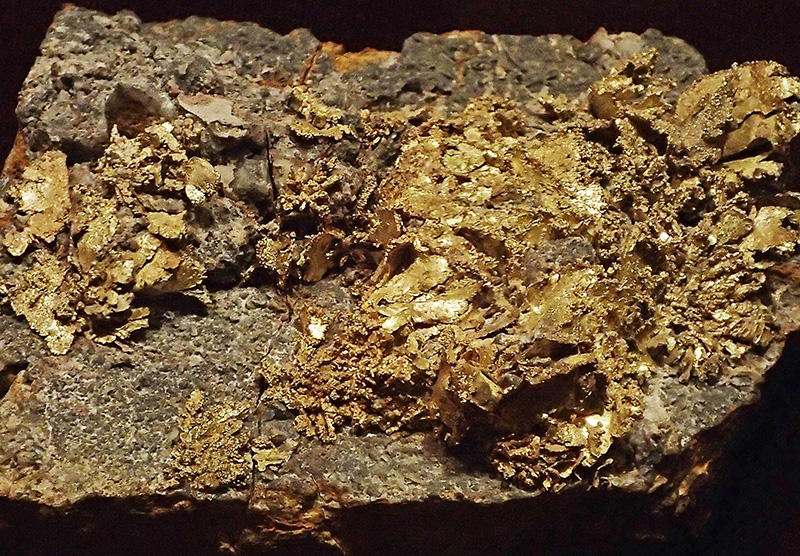
Here are some key factors contributing to the high concentrations of gold in this region:
- Geological Formation: Colorado’s geology played a crucial role in gold formation. The Rocky Mountains were formed by the uplift of the earth’s crust, which caused deep-seated rocks to be pushed to the surface. This process often brings up mineral-rich fluids and rocks from the earth’s mantle and lower crust.
- Volcanic Activity: The region experienced significant volcanic activity millions of years ago. This volcanic activity was responsible for bringing molten rock (magma) and associated mineral-rich fluids closer to the earth’s surface. As this magma cooled and crystallized, it formed veins of minerals, including gold.
- Hydrothermal Processes: Gold in Colorado is largely found in hydrothermal veins. These are formed when hot, mineral-rich water flows through cracks in the earth’s crust, depositing minerals, including gold, as the water cools. The Colorado Mineral Belt, a region stretching northeast-southwest across the Rocky Mountains, is a prime example of this process.
- Erosion and Placer Deposits: Over millions of years, erosion from water and other natural elements broke down the rocks containing gold, washing the gold into streams and rivers. This process created placer deposits, where gold particles and nuggets accumulate in stream beds, making them accessible to early prospectors.
- Tectonic Activity: The tectonic activity that created the Rockies also created numerous faults and fractures in the earth’s crust. These faults acted as channels for mineral-rich fluids to move, depositing gold and other minerals in these fractured zones.
- Ancient River Systems: Ancient rivers that once flowed through the Rockies played a role in eroding and concentrating gold in certain areas. As these rivers eroded the landscape, they also transported and deposited gold, leading to the formation of gold-rich placer deposits.
The combination of these geological processes over millions of years led to the formation of significant gold deposits in Colorado, making it a hotspot for gold mining during the gold rush in the 19th century and continuing to be a region of interest for gold mining and exploration.
Source: National Park Service
Check out the video about gold mining in Colorado:
What is the History of Gold Mining in Colorado?
Who Discovered Gold in Colorado?
The first substantial gold discovery was made by George A. Jackson in 1859 at the present site of Idaho Springs, leading to a booming mining town. This discovery played a pivotal role in the establishment and development of Colorado, as prospectors traced the placer gold to its source in the mountains west of Denver, leading to further exploration and mining activities
The first gold rush
The journey of gold mining in Colorado began in earnest with the Pikes Peak Gold Rush of 1858-1861. This rush, following the discovery of gold near present-day Denver, attracted thousands of prospectors and set the stage for Colorado’s mining saga.
This gold rush played a significant role in the establishment of the state of Colorado.
Gold discoveries began around Denver, and prospectors traced the placer gold to its source in the mountains west of Denver, following the Colorado Mineral Belt in a southwest direction across the state to its terminus in the San Juan Mountains. The Colorado Mineral Belt, a large alignment of mineral deposits stretching northeast-southwest, has been a crucial source of gold and silver in the state. The gold was washed down via the South Platte River and smaller waterways such as Clear Creek and Ralston Creek2
The Cripple Creek district, which has been one of the most productive gold-producing districts in Colorado, has contributed significantly to the state’s gold production3
As the initial frenzy of the gold rush subsided, more substantial gold discoveries were made in the Central City-Black Hawk area in the 1860s. These finds led to the rapid development of these areas, drawing in a new wave of miners and settlers.
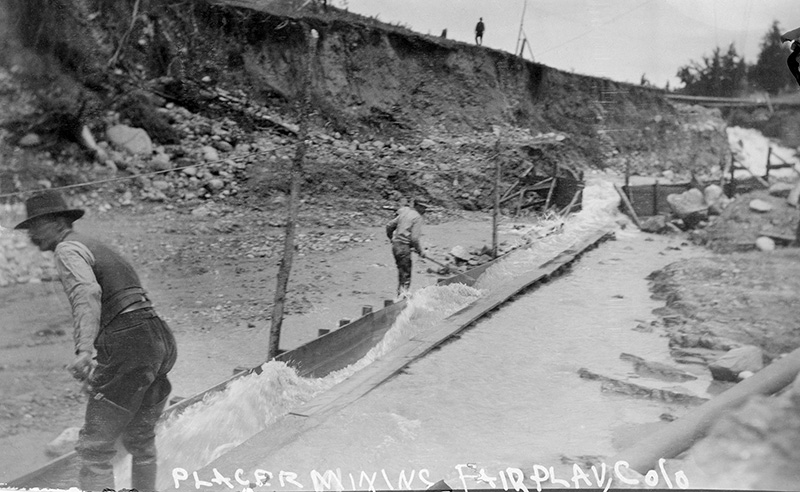
Technological advancements
Gold mining in Colorado also contributed to significant technological advancements in the late nineteenth and early twentieth centuries. The introduction of gold cyanidation in 1895, alongside chlorination, revolutionized the extraction process in the mills. By 1895, half of Colorado’s gold production of 660,000 ounces came from the district. The industry continued to grow, with half a million Troy ounces of gold produced in 1897 and 900,000 troy ounces in 1900, comprising two-thirds of the US output. By 1920, 41 mines were active, and cumulative gold production had exceeded 500 tonnes.

The late 19th century witnessed another significant event in Colorado’s gold mining history with the discovery of one of the world’s largest gold strikes in the Cripple Creek and Victor area in the 1890s. This discovery led to the establishment of numerous mining towns, some of which have now turned into ghost towns. The annual gold output of that time shows a large spike due to the Cripple Creek gold extraction; see chart.
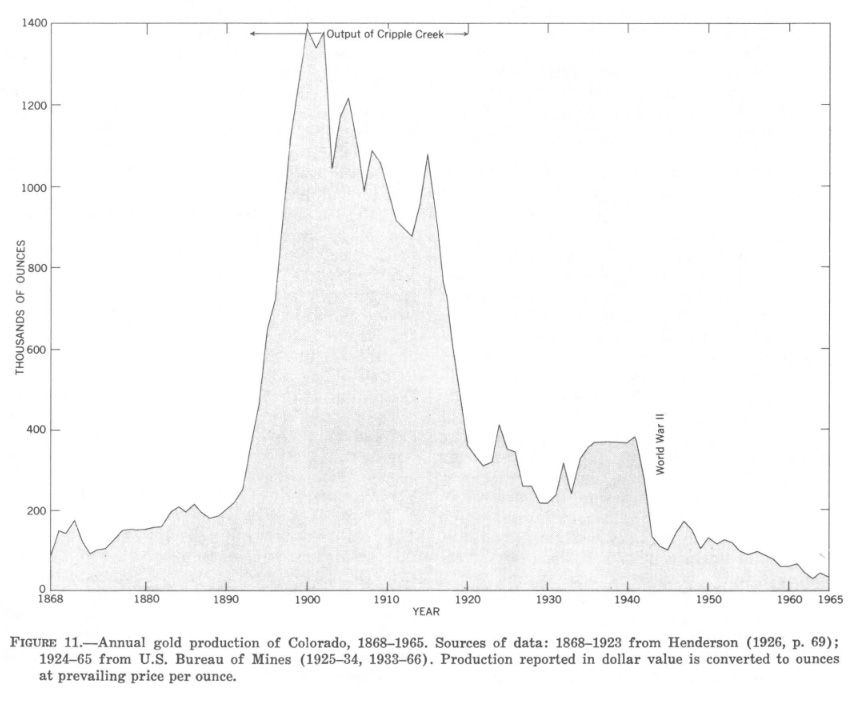
The nature of gold mining in Colorado evolved over time. The early days of panning for gold in streams gave way to hard rock mining, which involved delving deeper into the earth to access gold veins. This transition marked a shift towards more industrialized and large-scale mining operations. The arrival of railroads in mining areas played a crucial role in this transformation, facilitating the transport of gold and mining supplies and thereby fueling further growth of the mining industry.
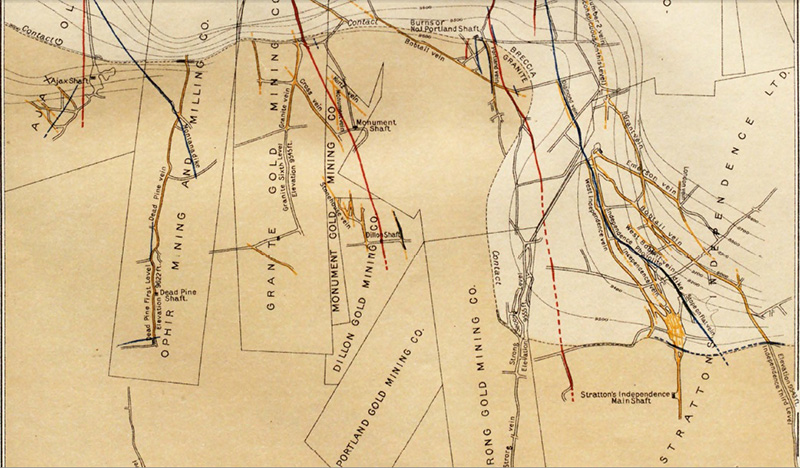
However, this boom brought with it significant environmental and social impacts. Many mining towns, once thriving centers of activity, became ghost towns after the gold deposits were depleted. The large-scale mining operations, particularly in the 20th century, led to substantial environmental impacts, including landscape alterations and pollution.
The 20th century brought its own set of challenges and changes to gold mining in Colorado. In the modern era, gold mining in Colorado is characterized by stricter environmental regulations and the use of more advanced mining techniques. For example, the Cripple Creek & Victor mine has evolved into a significant open-pit operation, reflecting the modern face of gold mining.
Sources: Colorado Geological Survey, National Park Service
How much gold has been mined in Colorado?
Until today, the state has produced more than 45 million ounces of gold (1.275 tonnes), with half of it coming from the Victor Cripple Creek area. In the last
Most of the other half from the Colorado mineral belt, extending from San Juan Mountains northeastward through the Central City and Boulder districts.
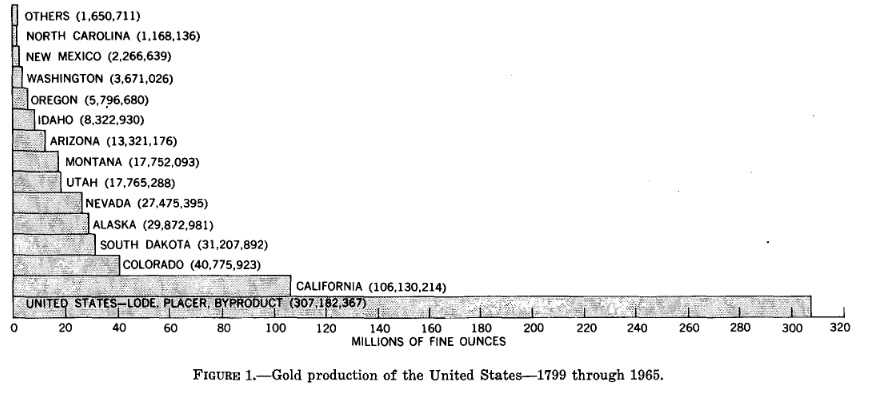
The next chart shows the annual gold output of the state from 1997 to 2021, based on the only major gold mine of the state, the Cripple Creek & Victor mine. In 2005 and 2026, gold of the Golden Wonder mine was added to the statistics. Gold production in 1997 stood at 7.1 tonnes, rose to 11 tones in 2006, fell again until it reached a new peak in 2017 with 14 tonnes produced. From then on, the annual output fell sharply by nearly 50%. In 2021 only 6.8 tonnes of gold was extracted from the state’s soil.
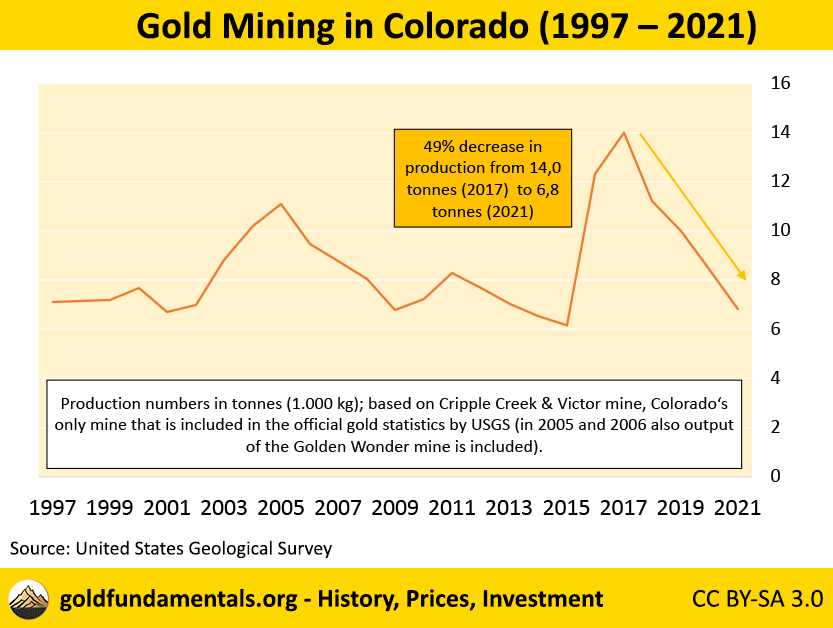
What is the Current State of Gold Mining in Colorado?
The current state of gold mining in Colorado is characterized by a mix of small-scale operations, recreational mining, and a focus on environmental stewardship.
There is only one large gold mine still operational in the state: In Teller County, the Cripple Creek and Victor (CC&V) mine stands as Colorado’s premier gold producer.
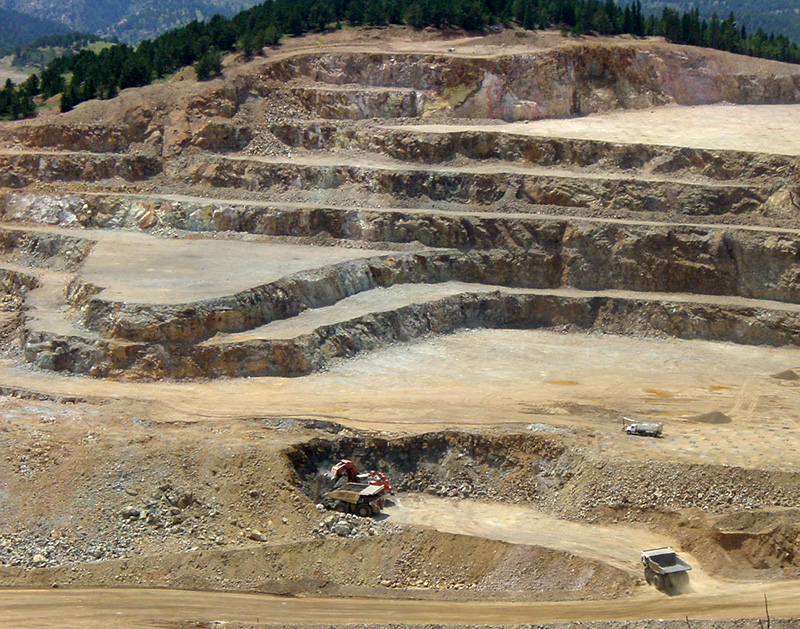
As of 2018, this open pit mine propelled Colorado to become the third-leading gold-producing state in the U.S. (output fell considerably the next years, see chart above), yielding 360,000 ounces of gold (whose annual output dropped by 40% until 2021). Beyond this major operation, smaller quantities of placer gold are also extracted from sand and gravel in various river and stream locations, including the South Platte, Arkansas, and Colorado Rivers, as well as Clear Creek. Moreover, Colorado hosts a number of small-scale lode gold mines, primarily managed by individuals or small groups, contributing modest but high-grade gold and silver ore to the state’s overall production.
Many former mining sites in Colorado have been converted into tourist attractions, offering tours and educational experiences about the state’s gold mining history. The legacy of gold mining is still evident across Colorado, with historic mining towns and artifacts forming a part of the cultural and historical landscape.
What is the major gold mine in Colorado?
The US Geological Survey Minerals Yearbook lists in its most recent overview of 44 leading gold operations in the US only one gold producing operations in the state of Colorado: Cripple Creek & Victor (owned by Newmont Mining).
The US state leading the ranking is Nevada with 27 operations, followed by Alaska with four operations.
List of the gold operation in Colorado:
| US Rank | Operation | County and State | Majority Owner (2024) | Qty 2020 |
Qty 2021 |
|---|---|---|---|---|---|
| 9 | Cripple Creek & Victor | Teller, CO | Newmont Mining Corp. | 8.460 | 6.840 |
Explanation:
Rank: a comparison of the output of US mines. Therefore, Cripple Creek & Victor, as the only Colorado mine, is ranked number 9 of all US gold mines. Eight of the ten biggest mines are in Nevada and one in Alaska.
Quantity: in kilogram; there are approx. 32 fine ounces in one kilogram
What is the major active gold mine in Colorado?
The open pit gold mine Cripple Creek & Victor is located near the town of Victor in the Cripple Creek mining district. Its historical name is Cresson Mine. AngoGold Ashanti, a South African gold mining company, sold it in 2015 to its current owner, Newmont Mining from Colorado.
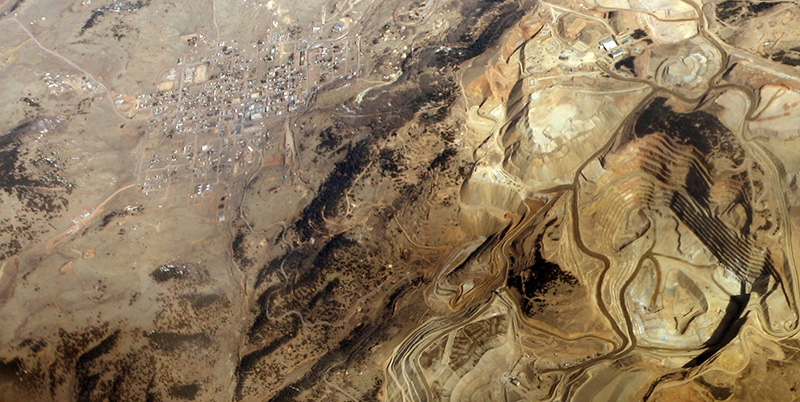
Some Facts:
- The operation consists of four open pit
- Its heap leach pad is one of the biggest in the world
- Milling operations ceased in Q1 2021
- Its mine life is expected to last only until 2038 (leach only).
- Mine production reached its peak in 2005 with 329,625 ounces of gold (9344 kg). In 2021 the production stood at only 6.840 kg, down from 8.460 from a year earlier
- The mine’s reserves are 1.6m ounce of gold, resources stand at 1.8 million ounce
Sources: USGS, miningdataonline, company website
How many gold reserves are in Colorado?
Criple Creek & Victor, the only industrial gold mine in Colorado, states its gold reserves as 1.6m ounce of gold and resources as 1.8 million ounce.
Source: company website
What Companies Mine Gold in Colorado?
Newmont Mining owns the only large gold mine in California, Cripple Creek & Victor. The company is Denver-based, was founded in 1921 and employs 14.300 people. The company has operations on three continents: America (north and south), Africa and Australia.
In detail:
- 2 operations in Ghana (both gold)
- 4 in Australia (gold and copper)
- 1 each in Argentina, Suriname, Mexico, Dominican Republic and Peru (mostly gold)
- 5 in Canada (gold and silver)
- 2 USA (mostly gold)
- 1 in Papua New Guinea
Sources: company website
Where are New Gold Mines Explored or Developed in Colorado?
There is no record of large gold developments in Colorado.
Is it Legal to Mine Gold in Colorado?
Gold mining is legal in Colorado, and there are various opportunities for individuals to engage in gold panning activities. Here are some key points regarding the legality of gold mining in Colorado:
- Public Lands: The Bureau of Land Management (BLM) allows gold panning, rockhounding, and non-mechanized sluicing on most public lands without requiring miners to obtain permits. However, some areas, such as the Arkansas River area, may require permits. In “certain designated areas, such as wilderness areas, Wilderness Study Areas, developed special management areas or recreation sites,” restrictions apply.
- Dredging and Sluicing: The state of Colorado requires authorization for suction dredge nozzles that have a diameter greater than 4 inches. Miners must comply with these regulations when engaging in dredging and sluicing activities.
- Mining Claims: Mining claims in Colorado do not convey title to the land on which claims are staked. Miners are required to file a Notice of Intent to Conduct Prospecting Operations and obtain financial guarantee warranties to proceed legally with prospecting activities.
- State Parks: If individuals are panning for gold within a state park in Colorado, any gold chunks or nuggets are considered state property and must be shown to park staff. However, gold flakes are generally allowed to be kept.
- Designated Areas: Gold panning is legal on public lands in Colorado, except for certain designated areas such as wilderness areas, Wilderness Study Areas, developed special management areas, or recreation sites.
In summary, gold mining, including panning and prospecting, is legal in Colorado, with specific regulations and guidelines that miners need to adhere to when engaging in these activities.
Sources: chron, findinggoldincolorado
Where Can I Pan for Gold in Colorado?
Check out the video about gold panning in at the South Boulder Creek Colorado:
In Colorado, there are many places where you can pan for gold. Here are some options:
- Hidee Gold Mine Tours and Panning – Located in Colorado, this site offers gold mine tours and panning experiences. It has a high rating and positive reviews.
- Cripple Creek & Victor Gold Mine – West of Colorado Springs, this mine offers opportunities for gold panning and has a rich history that can be relived today.
- Castlewood Canyon State Park – This park is one of the many beautiful creeks and streams in Colorado that promise lovely experiences for gold panning. Visitors are encouraged to minimize disturbance to the natural surface of the earth.
- Public Dig Sites Across Colorado – There are numerous public dig sites across Colorado where you can pan for gold. These sites allow pans and sluices, and some even offer the opportunity to use battery or gas-powered equipment after checking with the landowner.
These are just a few examples of places where you can pan for gold in Colorado. Whether you’re looking for a guided experience or prefer to explore public dig sites, there are various options available for gold panning enthusiasts in the state.
Remember: Anything found in state parks is technically state property. It’s generally okay to take flakes, but if you find chunks or nuggets, please show it to park staff
Remember that while some locations may be open to the public, others might have specific rules or be accessible only during certain seasons or days. It’s important to check local guidelines and respect environmental protection rules while engaging in gold panning activities.
Sources: Colorado Parks & Wildlife, findinggoldincolorado
Is There Gold in Other US States?
Check out gold production in neighboring states of Colorado: Utah, Wyoming, Nebraska, Kansas, Oklahoma, New Mexico and Arizona.
According to the U.S. Geological Survey (USGC), there are 11 states that mine gold and contribute towards the gold mining statistic: Nevada is responsible for the majority of gold output, around 72%, followed by Alaska (13%). 9 other contribute in sum to the remaining 15% of gold production: Arizona, California, Colorado, Idaho, Michigan, New Mexico, South Carolina, South Dakota, and Utah.
